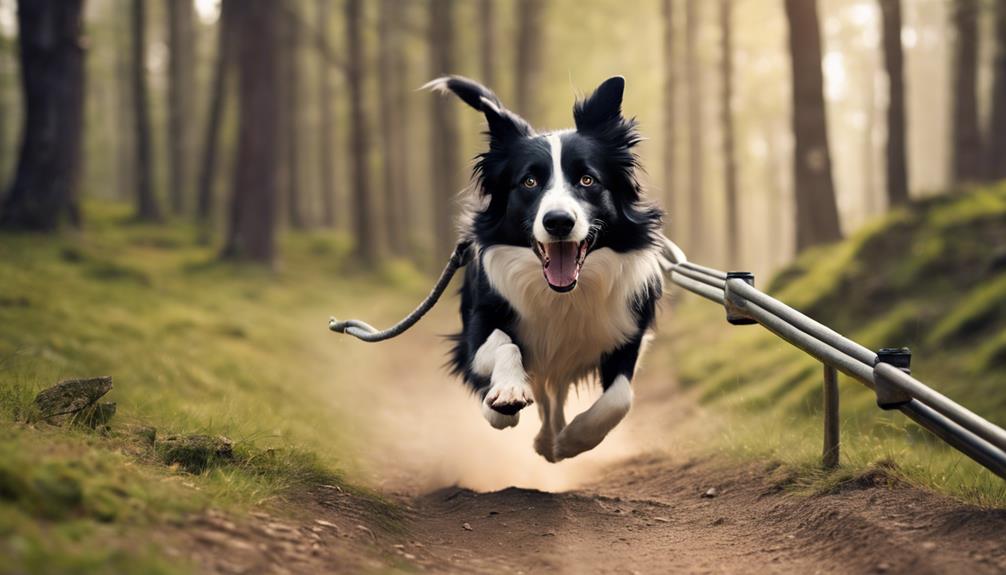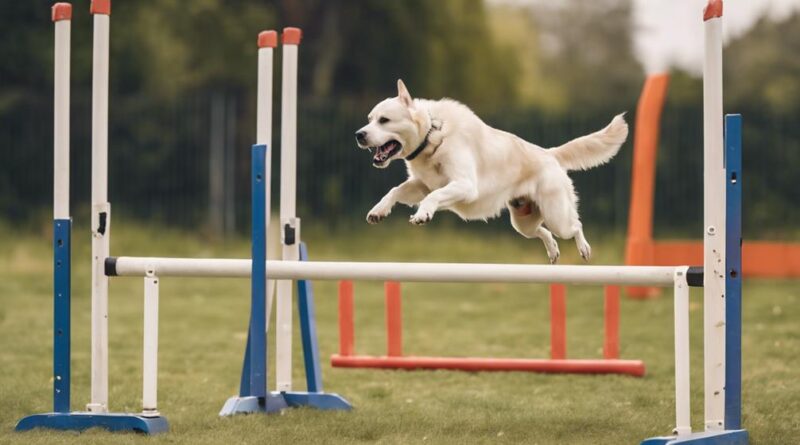What Are the Best Training Tips for Dog Sports?
Just like a coach fine-tuning a team for a championship, your approach to training your furry athlete for dog sports requires precision and dedication.
From mastering basic obedience to honing specific skills, the journey to success in the competitive world of dog sports is multifaceted.
As you navigate through the intricacies of training your canine companion, uncover the secrets to maximizing performance and achieving your goals in this specialized arena.
Basic Obedience Training
When starting basic obedience training with your dog, consistency is key to success. Using clicker training and positive reinforcement techniques can be highly effective in teaching your furry friend good behavior. Clicker training involves using a small device that makes a clicking sound to mark the precise moment your dog performs the desired action, followed by a reward. This method helps your dog understand what behavior is being rewarded, making the training process clearer and more efficient.
Leash manners and impulse control are essential skills to focus on during basic obedience training. Teaching your dog to walk politely on a leash without pulling can make your outings more enjoyable for both of you. Positive reinforcement, such as rewarding your dog for walking nicely beside you, can help reinforce good leash manners. Additionally, working on impulse control exercises, like having your dog wait patiently before receiving a treat or going outside, can improve their self-control and overall obedience.
Consistency in training methods and expectations is crucial for your dog to learn and retain obedience skills. By setting clear rules and boundaries and consistently reinforcing them through positive reinforcement, you can help your dog become a well-behaved and obedient companion. Remember to be patient and understanding during the training process, as every dog learns at their own pace.
Conditioning and Fitness
To enhance your dog's performance in dog sports, focusing on conditioning and fitness is crucial. Proper nutrition and hydration play a significant role in maintaining your dog's overall health and performance. Ensure your dog is receiving a balanced diet rich in nutrients to support their energy levels and muscle recovery. Adequate hydration is also essential before, during, and after training sessions to prevent fatigue and overheating.
Injury prevention is paramount in conditioning your dog for sports. Incorporate warm-up routines before any strenuous activity to prepare your dog's muscles and joints for exercise. This can include light jogging, stretching, and agility drills. Cooling down after a workout with gentle exercises and stretches helps reduce muscle soreness and stiffness.
Regular exercise tailored to your dog's specific sport is key to improving their fitness level. Gradually increase the intensity and duration of workouts to build endurance and strength. Monitor your dog's progress closely and adjust their training regimen as needed to prevent overexertion and injuries.
Focus and Engagement
Maintaining your dog's focus and engagement during training sessions is vital for optimizing their performance in dog sports. To enhance your dog's focus, try engagement techniques such as using high-value treats or toys that your dog loves. These items can help keep your dog motivated and attentive during training. Additionally, incorporating short and engaging training sessions can prevent boredom and maintain your dog's interest.
Distraction management is crucial when aiming to improve focus. Find a training environment with minimal distractions to help your dog stay focused on the task at hand. Gradually increase the level of distractions as your dog progresses in their training. This gradual exposure can help your dog learn to remain focused even in stimulating environments.
When it comes to motivation strategies, positive reinforcement is key. Praise and reward your dog for correct behaviors to build their attention and enthusiasm for training. Using a cheerful and encouraging tone can also help maintain your dog's engagement throughout the training session.
Attention building exercises, such as teaching your dog to make eye contact with you on command, can further enhance focus. These exercises strengthen the bond between you and your dog while improving their ability to concentrate on your directions. By implementing these techniques consistently, you can boost your dog's focus and engagement, leading to improved performance in dog sports.
Reward-Based Training
Enhance your dog's learning experience by implementing reward-based training techniques. Positive reinforcement is a powerful tool in dog training. By using rewards such as treats, toys, or praise, you can encourage your dog to exhibit desired behaviors. When your dog performs the desired behavior, immediately follow it with a reward to reinforce that behavior positively. This method helps your dog associate the action with a positive outcome, making them more likely to repeat it in the future.
Clicker training is another effective reward-based training technique. It involves using a small device that makes a clicking sound to mark the exact moment your dog performs the desired behavior. The sound of the clicker serves as a clear signal for your dog, indicating that they've done something right and will receive a reward. Clicker training helps to pinpoint and communicate precisely what behavior is being rewarded, leading to faster learning and clearer communication between you and your dog.
Handling and Communication
When handling and communicating with your dog during training sessions, ensure your actions are consistent and your cues are clear. Building trust is key in dog sports training. Dogs respond well to handlers they trust, so it's important to establish a strong bond through consistent training and positive reinforcement.
Body language plays a crucial role in how your dog interprets your cues. Dogs are highly attuned to body language, so use this to your advantage during training sessions. Stand tall and confident to convey leadership, and use hand signals in conjunction with verbal cues to reinforce commands. Consistency in your body language will help your dog understand what you're asking for.
Effective communication is a two-way street. Pay attention to your dog's body language as well. Look for signs of stress or confusion, and adjust your training approach accordingly. By maintaining open and clear communication channels, you'll strengthen your bond and improve your overall training experience.
Mental Stimulation Activities
Engage your dog's mind with challenging mental stimulation activities that promote learning and problem-solving. Interactive puzzles and scent games are excellent ways to keep your dog mentally sharp and engaged. These activities encourage your dog to use their problem-solving skills and enhance their cognitive abilities. By introducing new and exciting challenges, you can prevent boredom and keep your dog mentally stimulated.
Additionally, agility drills and obstacle courses provide a great outlet for mental stimulation. These activities not only challenge your dog physically but also require them to think strategically to navigate through the course effectively. Agility drills can improve your dog's focus, coordination, and decision-making skills while keeping them mentally engaged and active.
Incorporating mental stimulation activities into your dog's training routine can have numerous benefits, including improved overall behavior, enhanced problem-solving abilities, and increased mental agility. By incorporating interactive puzzles, scent games, agility drills, and obstacle courses into your training regimen, you can keep your dog engaged, happy, and mentally sharp. Remember, a stimulated mind leads to a happy and well-rounded dog!
Cross-Training Benefits

To maximize your dog's performance and overall fitness, incorporating cross-training routines into their regimen can provide a range of physical and mental benefits. Agility drills are a fantastic way to improve your dog's coordination, speed, and responsiveness. By including activities such as weaving through poles, navigating obstacle courses, and practicing quick turns, you can enhance your dog's agility and mental acuity. These drills not only boost physical prowess but also stimulate your dog's problem-solving skills.
In addition to agility drills, endurance exercises are crucial for enhancing your dog's stamina and cardiovascular health. Long walks, hikes, or jogs can help build your dog's endurance over time. Swimming is another excellent endurance activity that's gentle on the joints while providing a full-body workout. Endurance exercises are particularly beneficial for dog sports that require sustained energy output, such as agility competitions or flyball.
Consistency and Patience
Maximizing your dog's performance and fitness through cross-training includes the essential elements of consistency and patience. Consistency in your training routine will help your dog understand expectations and build endurance over time. Patience is key as you work with your dog, allowing them to progress at their own pace while strengthening the bond between you both.
Key Points to Remember:
- Building Endurance: Consistently engaging in various training activities will gradually improve your dog's stamina and endurance. Whether it's agility, obedience, or swimming, each session contributes to enhancing your dog's physical capabilities.
- Strengthening Bond: Patience plays a crucial role in strengthening the bond with your furry companion. By patiently working through challenges and celebrating small victories together, you create a deeper connection based on trust and understanding.
- Consistency is Key: Regular training sessions, even if they're short, are more effective than sporadic, intense sessions. Consistency helps your dog understand what's expected of them and reinforces positive behaviors consistently.
Frequently Asked Questions
How Can I Improve My Dog's Speed and Agility for Dog Sports?
To boost your dog's speed and agility for dog sports, focus on speed drills to increase their quickness. Set up agility courses to enhance their agility and coordination. These activities will help your furry friend become faster and more nimble, improving their performance in dog sports.
Consistent training and positive reinforcement will ensure steady progress towards achieving your training goals.
What Are Some Common Mistakes to Avoid When Training for Dog Sports?
When training for dog sports, you should watch out for common distractions that can hinder progress. Proper conditioning is key to success.
Avoid making mistakes by ensuring consistent reinforcement and effective communication with your furry companion.
Are There Specific Dietary Recommendations for Dogs Involved in Competitive Sports?
When it comes to dietary recommendations for dogs in competitive sports, focus on proper meal timing and consider adding nutritional supplements. These elements can enhance your dog's performance and overall health.
Be mindful of when you feed your dog before an event to ensure optimal energy levels. Additionally, consult with a veterinarian or canine nutritionist to determine the best supplements that can support your dog's specific needs for athletic activities.
How Can I Prevent My Dog From Getting Bored or Burnt Out From Participating in Dog Sports?
To keep your dog engaged in sports and prevent burnout, provide mental stimulation and enrichment. Incorporate a variety of activities to keep things interesting. Mix up training routines, introduce new challenges, and offer interactive toys or puzzles.
Rotate between different sports to prevent monotony. Bond with your dog through playtime and positive reinforcement to maintain enthusiasm. By keeping things fresh and exciting, you can help prevent boredom and burnout in your furry athlete.
What Are Some Advanced Training Techniques for Mastering Complex Maneuvers in Dog Sports?
To master complex maneuvers in dog sports, focus on mental sharpness with advanced training drills. Enhance coordination and handling skills by practicing consistently.
Engage your dog's mind with challenging tasks that require precision and agility. Stay patient and keep sessions fun to avoid burnout.
With dedication and effort, you can achieve proficiency in executing intricate moves together.
Conclusion
In conclusion, remember to have fun and stay positive while training your dog for sports. Consistency, patience, and using reward-based methods will help your furry friend reach their full potential.
Keep them physically fit and mentally stimulated, and don't forget to enjoy the journey together. With the right training tips and techniques, you and your dog can achieve great success in the world of dog sports. Keep up the good work!
